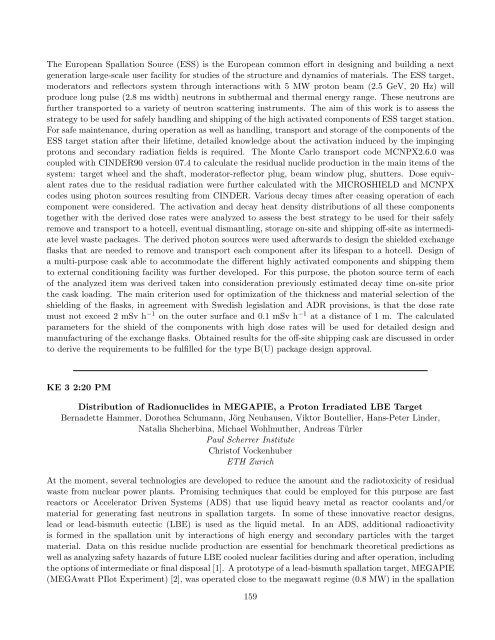Program - Brookhaven National Laboratory
Program - Brookhaven National Laboratory
Program - Brookhaven National Laboratory
You also want an ePaper? Increase the reach of your titles
YUMPU automatically turns print PDFs into web optimized ePapers that Google loves.
The European Spallation Source (ESS) is the European common effort in designing and building a next<br />
generation large-scale user facility for studies of the structure and dynamics of materials. The ESS target,<br />
moderators and reflectors system through interactions with 5 MW proton beam (2.5 GeV, 20 Hz) will<br />
produce long pulse (2.8 ms width) neutrons in subthermal and thermal energy range. These neutrons are<br />
further transported to a variety of neutron scattering instruments. The aim of this work is to assess the<br />
strategy to be used for safely handling and shipping of the high activated components of ESS target station.<br />
For safe maintenance, during operation as well as handling, transport and storage of the components of the<br />
ESS target station after their lifetime, detailed knowledge about the activation induced by the impinging<br />
protons and secondary radiation fields is required. The Monte Carlo transport code MCNPX2.6.0 was<br />
coupled with CINDER90 version 07.4 to calculate the residual nuclide production in the main items of the<br />
system: target wheel and the shaft, moderator-reflector plug, beam window plug, shutters. Dose equivalent<br />
rates due to the residual radiation were further calculated with the MICROSHIELD and MCNPX<br />
codes using photon sources resulting from CINDER. Various decay times after ceasing operation of each<br />
component were considered. The activation and decay heat density distributions of all these components<br />
together with the derived dose rates were analyzed to assess the best strategy to be used for their safely<br />
remove and transport to a hotcell, eventual dismantling, storage on-site and shipping off-site as intermediate<br />
level waste packages. The derived photon sources were used afterwards to design the shielded exchange<br />
flasks that are needed to remove and transport each component after its lifespan to a hotcell. Design of<br />
a multi-purpose cask able to accommodate the different highly activated components and shipping them<br />
to external conditioning facility was further developed. For this purpose, the photon source term of each<br />
of the analyzed item was derived taken into consideration previously estimated decay time on-site prior<br />
the cask loading. The main criterion used for optimization of the thickness and material selection of the<br />
shielding of the flasks, in agreement with Swedish legislation and ADR provisions, is that the dose rate<br />
must not exceed 2 mSv h −1 on the outer surface and 0.1 mSv h −1 at a distance of 1 m. The calculated<br />
parameters for the shield of the components with high dose rates will be used for detailed design and<br />
manufacturing of the exchange flasks. Obtained results for the off-site shipping cask are discussed in order<br />
to derive the requirements to be fulfilled for the type B(U) package design approval.<br />
KE 3 2:20 PM<br />
Distribution of Radionuclides in MEGAPIE, a Proton Irradiated LBE Target<br />
Bernadette Hammer, Dorothea Schumann, Jörg Neuhausen, Viktor Boutellier, Hans-Peter Linder,<br />
Natalia Shcherbina, Michael Wohlmuther, Andreas Türler<br />
Paul Scherrer Institute<br />
Christof Vockenhuber<br />
ETH Zurich<br />
At the moment, several technologies are developed to reduce the amount and the radiotoxicity of residual<br />
waste from nuclear power plants. Promising techniques that could be employed for this purpose are fast<br />
reactors or Accelerator Driven Systems (ADS) that use liquid heavy metal as reactor coolants and/or<br />
material for generating fast neutrons in spallation targets. In some of these innovative reactor designs,<br />
lead or lead-bismuth eutectic (LBE) is used as the liquid metal. In an ADS, additional radioactivity<br />
is formed in the spallation unit by interactions of high energy and secondary particles with the target<br />
material. Data on this residue nuclide production are essential for benchmark theoretical predictions as<br />
well as analyzing safety hazards of future LBE cooled nuclear facilities during and after operation, including<br />
the options of intermediate or final disposal [1]. A prototype of a lead-bismuth spallation target, MEGAPIE<br />
(MEGAwatt PIlot Experiment) [2], was operated close to the megawatt regime (0.8 MW) in the spallation<br />
159
















